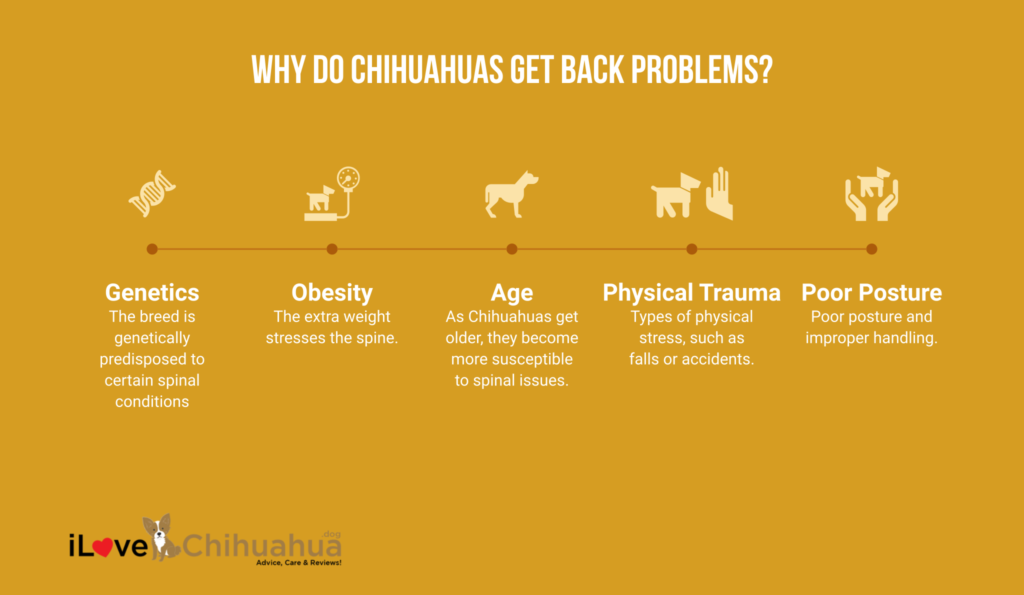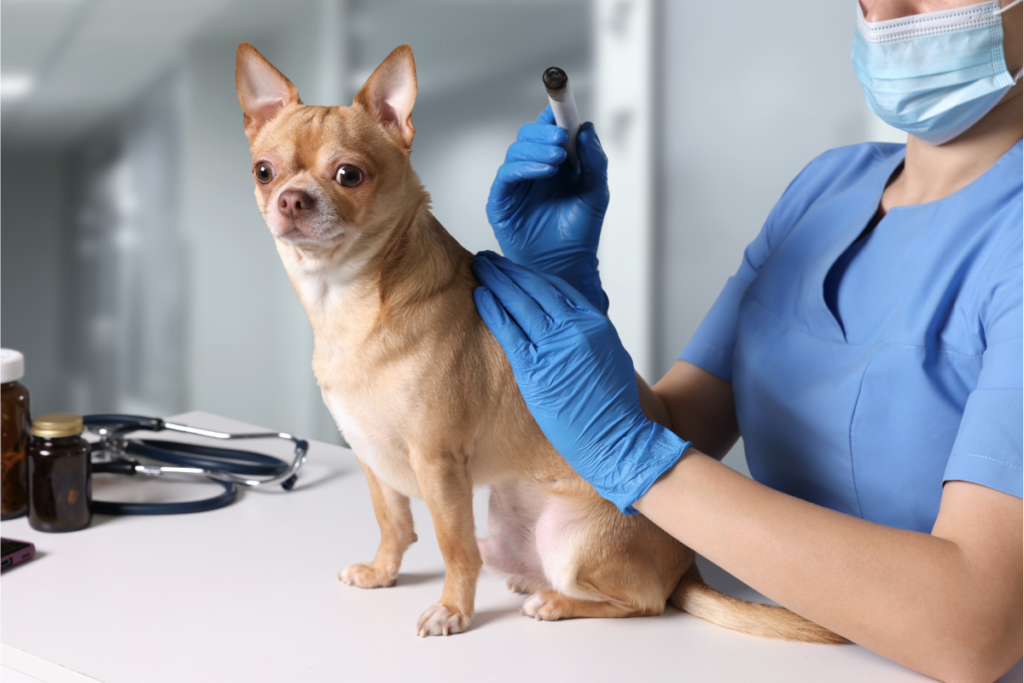If you’re reading this, one of these little, energetic puppies likely lives with you. Chihuahua back issues are one condition that may plague these little dogs despite their reputation for having large personalities crammed into little bodies. But don’t be concerned. You’re at the proper location. We’ll go into great detail on handling Chihuahua back problems so your pet has a pain-free, joyful life.
Chihuahuas may be little, but their fragile structure may make them more susceptible to back issues. These problems might be anything from little pain to more severe illnesses that need medical attention. Responsible Chihuahua parents need to be aware of the common back problems that their dogs may have, the warning signals to watch out for, and, most importantly, how to treat and avoid these problems.
Together, let’s set out on this adventure to provide ourselves with the information and resources we need to maintain the comfort and well-being of our Chihuahuas.
Common Types of Back Problems in Chihuahuas

As a Chihuahua owner, you must know the common back problems that can affect your furry friend. The following are some of the frequently encountered conditions:
👉🏻Intervertebral Disc Disease (IVDD)
IVDD is the most common type of back problem affecting Chihuahuas. Their intervertebral discs can degenerate as they age, leading to bulging or herniation. The condition can also be genetic, so discussing potential risks with your veterinarian if you’re considering breeding is essential.
👉🏻Spinal Cord Injuries
Although spinal cord injuries can occur due to accidents or falls, they can also be a result of rough handling. It’s crucial to handle your Chihuahua with care and avoid jerky movements that could cause injury to their spine.
👉🏻Degenerative Disc Disease
Chihuahuas are also at risk of developing degenerative disc disease, which is a progressive condition that can cause chronic pain and mobility issues. To forestall the start of this ailment, it is necessary to keep a close eye on your pet’s weight and ensure they have access to a nutritious meal and a regular exercise program.
Causes of Back Problems in Chihuahuas

Knowing the various causes and risk factors associated with back problems is crucial if you own a Chihuahua. If you know these variables, you will be more equipped to take preventative measures or treat spinal disorders in your four-legged buddy.
👎🏻Genetics
One of the leading causes of back problems in Chihuahuas is genetics. The breed is genetically predisposed to certain spinal conditions, such as intervertebral disc disease. It means that even with proper care and preventive measures, your Chihuahua may still develop back problems due to their genetic makeup.
👎🏻Obesity
Another significant risk factor for spinal issues in Chihuahuas is obesity. The extra weight stresses the spine, leading to back problems over time. Therefore, keeping your furry friend at a healthy weight is essential by providing a balanced diet and regular exercise.
👎🏻Age
As Chihuahuas get older, they become more susceptible to spinal issues. Degenerative disc disease, for instance, is a common condition that affects aging Chihuahuas. Wear and tear on the spine’s discs cause pain and discomfort.
👎🏻Physical Trauma
Back issues in Chihuahuas may also be brought on by other types of physical stress, such as falls or accidents. The force of the hit may cause lesions to the spinal cord or herniated discs, both of which may result in a great deal of pain and agony.
👎🏻Poor Posture
Finally, poor posture and improper handling can also contribute to spinal issues in Chihuahuas. For instance, allowing your furry friend to jump off high furniture can put undue pressure on their spine, leading to back problems over time. Therefore, it is essential to handle your pet properly and encourage good posture habits throughout their life.
Symptoms of Back Problems in Chihuahuas

Knowing the common symptoms is crucial if you suspect your Chihuahua is experiencing back problems. Prompt treatment and improved long-term results may result from early diagnosis.
- Difficulty walking: Watch out for limping or staggering, especially in the hind legs.
- Back pain: Your Chihuahua may cry if you touch their back or when picked up.
- Weakness in the hind legs: Your pet may have trouble standing or walking independently.
- Changes in behavior: Your Chihuahua may show signs of discomfort, become less active, or be more irritable than usual.
It is essential to note that some Chihuahuas may not display any signs of back problems initially. On the other hand, if treatment is not received, the illness may worsen and cause more severe symptoms.
Diagnosing Chihuahua Back Problems

When your Chihuahua is showing symptoms of back problems, it is essential to consult a veterinarian as soon as possible. A prompt and accurate diagnosis can help determine the specific condition and the appropriate treatment needed. Here are the diagnostic procedures commonly used by veterinarians:
- Physical Examination: Your Chihuahua will need a comprehensive physical examination by the veterinarian, during which the vet will evaluate its mobility, reflexes, and responsiveness. This assessment can assist in determining whether or not there are any obvious indicators of damage or pain.
- Imaging Tests: X-rays, CT scans, and MRI scans can provide detailed images of your Chihuahua’s spine, allowing for a closer examination of the bones, cartilage, and soft tissue. These examinations may assist in identifying any abnormalities or injuries that may have occurred to the spine.
- Neurological Evaluations: A neurological evaluation may be necessary if your Chihuahua shows signs of neurological problems. This evaluation can assess your pet’s motor function, reflexes, and sensory perception.
Based on the results of these diagnostic procedures, your veterinarian can determine the specific type of back problem your Chihuahua is suffering from and recommend the most effective treatment plan. Diagnosing the condition can help prevent further discomfort and ensure your Chihuahua receives proper care and support.
Treating Back Problems in Chihuahuas
You should take a variety of approaches to treat back issues in your Chihuahua, which vary according to the nature of the ailment and the degree of the problem. Your veterinarian will be able to offer a treatment strategy most suited to meet your pet’s requirements. This plan may include non-surgical or surgical procedures.
💊Pain Management
Your veterinarian may prescribe NSAIDs and analgesics for mild to severe back discomfort in your Chihuahua. These medicines may interact with other drugs and have negative effects, so follow your vet’s advice. Human pain drugs may be hazardous to dogs, so check your vet before giving your Chihuahua any.
💊Physical Therapy
Back-pain Chihuahuas might benefit from physical therapy. Your veterinarian may recommend exercises and stretches that can help strengthen your pet’s back muscles and improve range of motion.
Sometimes, your veterinarian may refer you to a veterinary rehabilitation specialist who can provide specialized physical therapy treatments such as acupuncture, hydrotherapy, and electrical stimulation.
💊Surgical Interventions
In severe back disorders such as intervertebral disc disease or spinal cord damage, surgery may be essential to relieve pain and restore movement.
There are several surgical options available, including laminectomy, hemilaminectomy, and spinal fusion. Your veterinarian can help you understand the benefits and risks associated with these procedures and recommend the best option for your Chihuahua.
💊Combination of Treatments
In many cases, a combination of treatments may be necessary to effectively manage your Chihuahua’s back problem. Your veterinarian may recommend a combination of pain management, physical therapy, and surgical intervention to provide the best possible outcome for your pet.
It is important to work closely with your veterinarian to monitor your pet’s progress and make any necessary adjustments to the treatment plan. Your Chihuahua can regain mobility and lead a happy, healthy life with appropriate treatment.
Preventing Back Problems in Chihuahuas

Preventative measures are key to ensuring the spinal health of your Chihuahua. A few lifestyle modifications can help reduce the risk of back problems or manage existing conditions. Here are some tips to keep in mind:
🍛Diet considerations
- In Chihuahuas, obesity increases the chance of back issues. Ensure your pet’s diet is balanced and well-suited to their individual needs.
- Reduce the intake of high-calorie or fatty foods and treats.
- Feed your Chihuahua smaller, more frequent meals to avoid overeating.
🦮Exercise routines
- Chihuahuas benefit from regular exercise, but high-impact activities can strain their spine. Choose low-impact workouts like walking or swimming.
- Keep your Chihuahua active to maintain a healthy weight and build spine-supporting muscles. Chihuahuas tend to have shorter backs than other dog breeds.
- Always warm up your pet before exercise with a short walk or gentle stretching.
👆🏻Proper handling techniques
- Avoid carrying your Chihuahua for extended periods or in a way that places unnecessary strain on their back.
- Invest in a secure, well-fitting harness for your pet.
- When lifting your Chihuahua, use both hands and support their chest and hindquarters. Avoid pulling them up by their front legs or lifting them by their armpits.
🏠Environmental modifications
- Ensure your pet has access to a supportive bed or cage that will help keep their back and joints healthy.
- Avoid hard or slick surfaces that can cause slips and falls.
- If you have stairs in your home, consider installing a ramp to reduce the risk of accidental falls.
Rehabilitation Tips for Chihuahuas with Back Problems

If your Chihuahua has been diagnosed with a back problem, providing them with the best possible care and support during treatment is essential. Effective rehabilitation can help alleviate pain and improve mobility, enhancing your pet’s quality of life. Here are some tips that can aid in the recovery process:
✔Create a Comfortable Environment
After a back problem diagnosis, creating a comfortable environment for your Chihuahua is crucial. Ensure their bed is supportive and well-cushioned to avoid putting additional pressure on their spine. Consider using a ramp to help them climb onto furniture or beds, preventing any sudden movements that may exacerbate their condition.
✔Administer Pain Management
Your Chihuahua will likely be in pain while recovering, but your veterinarian may prescribe medicine to help control this discomfort. Make sure that you accurately give the medicine and completely adhere to their directions. It can potentially alleviate your pet’s discomfort by reducing pain and inflammation.
✔Incorporate Recommended Exercises
Your veterinarian may recommend specific exercises to aid in your Chihuahua’s rehabilitation. These may include stretching, swimming, or short walks that ensure minimal impact on the spine. Incorporating these exercises into your pet’s routine can help alleviate muscle stiffness, strengthening the muscles surrounding their spine.
✔Implement Rehabilitation Techniques
Depending on the severity of your Chihuahua’s back problem, your vet may recommend various rehabilitation techniques. These may include massage therapy, acupuncture, or hydrotherapy. These treatments can help improve circulation, alleviate pain, and promote healing.
✔Ensure Consistent Follow-up Care
After your Chihuahua’s initial treatment, it’s essential to follow up with your veterinarian consistently. It enables them to monitor your pet’s progress, make necessary adjustments to their treatment, and provide additional care.
Lifestyle Modifications for Chihuahuas with Back Problems

If your Chihuahua has experienced back problems, it’s important to implement lifestyle modifications to prevent future issues and support recovery. Here are some tips:
Diet Considerations:
- Obesity can strain your Chihuahua’s spine unnecessarily, leading to back problems. Maintain a healthy weight by giving your pet a balanced diet and not overfeeding.
- Consult your veterinarian to determine if your Chihuahua requires a special diet to prevent or manage back problems.
Exercise Routines:
- Regular exercise can help strengthen your Chihuahua’s back muscles and prevent future problems. However, certain activities, such as jumping and landing on hard surfaces, should be avoided to prevent injury.
- Consult your veterinarian to develop an exercise routine tailored to your Chihuahua’s needs and limitations.
Environmental Modifications:
- Ensure your Chihuahua’s environment is safe, comfortable, and supportive of their spinal health. Avoid placing their bed or resting areas on hard surfaces and provide cushioned surfaces.
- Use ramps instead of stairs to help your Chihuahua navigate their surroundings without putting strain on their back.
- Minimize jumping by placing food and water bowls at ground level and lifting your Chihuahua onto furniture rather than allowing them to jump up.
Regular Veterinary Check-ups:
- Regular veterinarian check-ups may identify and prevent Chihuahua back issues. Your veterinarian can assess your spinal health and suggest preventive measures or treatments as necessary.
- Make sure to follow the recommended wellness exam schedule and promptly communicate any concerns or changes in your Chihuahua’s behavior to your veterinarian.
Frequently Asked Questions
Q: Can a degenerative disc heal?
A: Degenerative discs cannot fully heal, as they are typically a natural part of aging and involve wear and tear of the spinal discs. However, various treatments and lifestyle changes can help manage symptoms, reduce pain, and improve function. These may include physical therapy, pain medications, exercise, and sometimes surgical options in severe cases. For individualized advice depending on your situation, see a healthcare expert.
Q: Is it normal to feel my Chihuahua’s spine?
A: It’s normal to feel the spine of a Chihuahua to some extent, as they have small and thin bodies. However, suppose the spine feels excessively prominent, or there are sudden changes in your Chihuahua’s weight or appearance. It is best to speak with a veterinarian to rule out any underlying medical conditions in such a situation.
Q: What vitamins should I take for degenerative disc disease?
A: Although there isn’t a single vitamin that can treat degenerative disc disease, eating a balanced diet full of nutrients like calcium, vitamin D, and vitamin C may help to keep your spine healthy overall. Also, consult a healthcare provider for personalized recommendations and consider supplements if deficiencies exist. However, always follow medical advice and avoid self-prescribing supplements.
Q: What home remedy can I give my dog for back pain?
A: It’s essential to consult with a veterinarian for any dog experiencing back pain. Home remedies should not be used without professional guidance, as they may not address the underlying cause and could potentially harm your pet. A vet can recommend appropriate treatments or medications to alleviate your dog’s pain safely and effectively.
Q: How do I know if my Chihuahua is in pain?
A: Signs that your Chihuahua may be in pain include whimpering, limping, changes in appetite, restlessness, aggression, or reluctance to be touched in certain areas. If you suspect your Chihuahua is in pain, it’s best to consult a veterinarian for a proper evaluation and treatment.
Conclusion
As a Chihuahua owner, you now have a comprehensive guide on managing back problems in your furry friend. By familiarizing yourself with the common types, causes, and symptoms, you can detect potential issues early and seek prompt veterinary care.
Remember, accurate diagnosis is crucial in determining the specific back problem your Chihuahua is experiencing, and this requires a veterinarian’s expertise. From conservative treatments such as pain management and physical therapy to surgical options, different approaches are available to alleviate your pet’s discomfort and improve their quality of life.
Preventing back problems in Chihuahuas involves adopting preventive measures and making necessary lifestyle modifications. You can reduce the risk of future back issues by managing your pet’s weight, implementing exercise routines, and encouraging proper handling techniques.
Here at ILoveChihuahua, we share our personal experiences as owners of this feisty breed. We talk about recommended methods, dog supplies picks, and advice on common Chihuahua problems. Our goal is to promote responsible dog ownership, so there would be fewer Chihuahuas in shelters.


